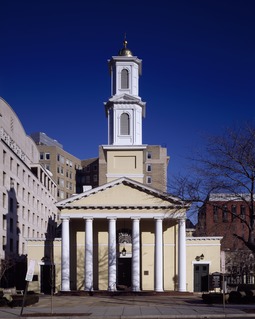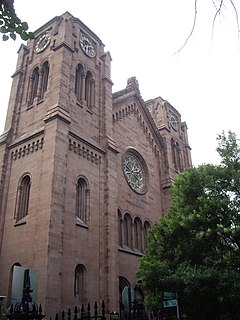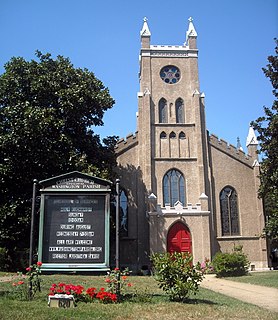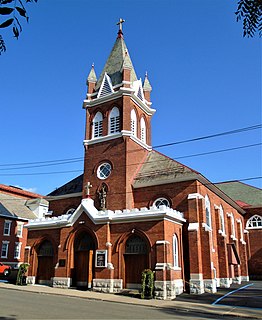
St. John's Episcopal Church, Lafayette Square is an historic Episcopal church located at Sixteenth Street and H Street NW, in Washington, D.C., along Black Lives Matter Plaza. The Greek Revival building, designed by Benjamin Latrobe, is adjacent to Lafayette Square, one block from the White House. It is often called the "Church of the Presidents".

Christ Church is an Episcopal church in the Old City neighborhood of Philadelphia. Founded in 1695 as a parish of the Church of England, it played an integral role in the founding of the Protestant Episcopal Church in the United States. In 1785, its rector, William White, became the first Presiding Bishop of the Episcopal Church.

St. Peter's Church is a historic Episcopal church located on the corner of Third and Pine Streets in Philadelphia, Pennsylvania. It opened for worship on September 4, 1761 and served as a place of worship for many of the United States Founding Fathers during the period of the Continental Congresses. The building was designated a National Historic Landmark in 1996. The church remains an active parish; the current rector is the Rev. Claire Nevin-Field.

St. George's Episcopal Church is a historic church located at 209 East 16th Street at Rutherford Place, on Stuyvesant Square in Manhattan, New York City. Called "one of the first and most significant examples of Early Romanesque Revival church architecture in America", the church exterior was designed by Charles Otto Blesch and the interior by Leopold Eidlitz. It is one of the two sanctuaries of the Calvary-St. George's Parish.

Holy Trinity Episcopal Church in Collington, Maryland is a historic place of worship dating back more than three centuries. Originally a chapel of ease for Queen Anne Parish, it became a separate parish in 1844.

Christ Church — known also as Christ Church, Washington Parish or Christ Church on Capitol Hill — is a historic Episcopal church located at 620 G Street SE in Washington, D.C., USA. The church is also called Christ Church, Navy Yard, because of its proximity to the Washington Navy Yard and the U.S. Marine Barracks nearby.

St. John's Episcopal Church and Rectory form a complex of log structures in Jackson, Wyoming. The rectory was built first: in 1911 it was a hostel and community center under the supervision of Episcopal Bishop Nathaniel Thomas. Church services were held there until 1916, when the church was built. The church and hostel are among the largest log structures in Jackson Hole.

Christ Church, founded in 1705, is a historic Episcopal parish located at 61 East Main Street in Oyster Bay, New York. Several church buildings have occupied this site, including one that served as soldiers' barracks during the Revolutionary War.

St. Luke's Episcopal Church is located in Beacon, New York, United States. The church complex of four buildings and a cemetery takes up a 12-acre (4.9 ha) parcel between Wolcott, Rector, Phillips and Union Streets. It was founded in 1832 as a religious school that soon became St. Anna's Church of Fishkill Landing.

St. Paul's Church is an historic Episcopal church located near the village of Fairlee, southwest of Chestertown, Kent County, Maryland. St. Paul's Church is one of the original thirty parishes created in 1692 by an Act of the General Assembly declaring the Church of England as the established religion of the Province of Maryland. The Georgian-styled building, completed in 1713, is the second-oldest Episcopal church on the Eastern Shore of Maryland.

Prince George Winyah Church is an Anglican church in Georgetown, South Carolina. Prince George Winyah is one of the oldest continuous congregations in South Carolina, and the church building is one of the oldest churches in continuous service in South Carolina. Prince George Winyah (Anglican) and Churchyard was named to the National Register of Historic Places on May 6, 1971.

St. James Church is a historic Episcopal church building at 86-02 Broadway in the Elmhurst neighborhood of Queens in New York City. It is the city's oldest surviving Anglican building and Church of England mission church. It is also alternatively called the Old St. James Church to distinguish it from the St. James Episcopal Church two blocks away.

Saint Stanislaus Roman Catholic Church Complex is a historic Roman Catholic church complex at 42, 46, 50 Cornell Street, and 73 Reid Street in Amsterdam, Montgomery County, New York. The complex consists of four contributing buildings:

St. Gabriel's Episcopal Church is an historic Episcopal Church church located in Douglassville, Pennsylvania. The church is a part of the Diocese of Bethlehem.

St. Michael's Episcopal Church, Parish House and Rectory is a group of architecturally-significant religious buildings located at 200-216 North Mill Street in Birdsboro, Berks County, Pennsylvania. It was added to the U.S. National Register of Historic Places in 1982.

St. George's Church is a historic Episcopal Church on VA 178, northeast of the junction with VA 180 in Pungoteague, Accomack County, Virginia. Established in the seventeenth century, the building, erected in 1738, is the oldest house of worship standing on Virginia's Eastern Shore. The church was added to the National Register of Historic Places in 1970.

The Episcopal Church of the Saviour, also known as Memorial Episcopal Church, is a parish church in the Episcopal Diocese of Iowa. The church is located in Clermont, Iowa, United States. The church building, along with the statue of David Henderson, was listed on the National Register of Historic Places in 2000.

St. Peter's Episcopal Church is a large historic Carpenter Gothic Episcopal church building located at the corner of Division and Telegraph streets in Carson City, Nevada. Built in 1868, it is the oldest Episcopal church still in use in Nevada. On January 3, 1978, it was listed on the National Register of Historic Places.

St. Thomas Chapel, also known as St. Thomas Episcopal Church or St. Thomas Protestant Episcopal Chapel, is a historic building located at 7854 Church Street in Middletown, Frederick County, Virginia, United States. Built in the 1830s, regular services were held at the Episcopal church for almost 100 years. The building has been restored twice, once after being heavily damaged during the Civil War, and again in the 1960s. The church was added to the Virginia Landmarks Register (VLR) and the National Register of Historic Places (NRHP) in 1973.

St. George's Episcopal Church is a historic Episcopal church in Griffin, Spalding County, Georgia. It was added to the National Register of Historic Places on April 7, 1994. It is located at 132 North Tenth Street.

























